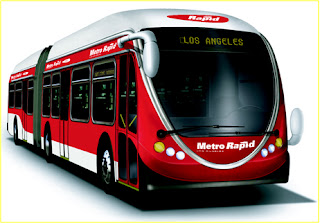That is not to say that transit advocates can go on a shock induced slumber now. The Mayor's decision of not amputating the Circulator system is right, even if the path towards an even higher imbalance between revenues (from parking tax surcharges and donations) and expenses is a slippery one. The deficit needs to be shored up by businesses that benefit from the Circulator, Hong Kong style! Bozzutto building in Locust Point can step up for the banner Line, Hopkins for the extended Purple Line, and so forth.
The next step needs to be to take the well studied parts of MTA's BNIP and distill from them a package of short-term bus improvements. High on my list, a beefed up Quick Bus system that makes sense and immediately addresses the current east west commute problems that were at the core of why the Red Line was proposed.
 |
| Quickbus to Paradise? |
Some may recall, that it was Ehrlich's Transportation Secretary Flanagan who introduced the QB in his and the Republican administration's quest to show that buses can work instead of rail. The QB 40 was the first Quick Bus and I met with Bob Flanagan a number of times during its study and implementation period. While the QB40 and its siblings are generally liked, they never lived up to being a premier bus service in the manner how Los Angeles had modeled its Rapid Bus system (copying heavily from Curitiba). The QB 40 became quickly a political football, the MTA never got queue jumpers, signal priority, designated lanes nor did it brand or promote the QB system very much and too many stops were added for really making it rapid. Tepid attempts of special stop equipment and more information at stops were quickly squashed because the MTA had no money to maintain any of the stuff. Unlike DC or LA rapid buses, MTA insisted on "interlining" (mixing buses up every day among all lines). In short, the QB has large untapped potential.
 |
| Branded LA Rapid Bus. A pilot line on Wilshire Blvd carried nearly 50,000 riders a day |
A short-term bus improvement package should focus on overlaying the intractable existing bus system with a network of express or rapid buses (QB style but better) that would shed all the baggage of the existing lines. The rapid bus lines would not be as long, they would go where the demand on the existing buses is the highest (based on current ridership analysis), where commute times are too long and where important destinations and hubs are served. They would not require the extensive and lengthy public input that any changes to existing lines need. The rapid buses would just like the QB 40 overlap with existing service and would use largely existing stock.
 |
| Special sign pylons were designed by Archplan with 212 Associates NY for the Baltimore Quickbus service but were only installed as prototypes for lack of maintenance funds |
However, the QB 40 runs again over too long a distance and as noted, politicians demanded additional stops, two steps that gobbled up efficiency. So, let's learn from those mistakes, and do what LA did: Every four or so blocks a rapid line, even spacing north-south, and east-west. Let's start with those two east west lines: Edmondosn Avenue (QB 40) and a new QB on North Avenue complementing the #13 and connecting to Metro, Light Rail and to Coppin, MICA, UB and Hopkins. This project can be linked to NDC's North Avenue streetscape project as a pilot for a new MTA and City partnership in which Baltimore DOT provides help with well paved curb lanes, signal priority, curb extensions at stops, designated lanes and all the rest.
 |
| Branded bus in DC (Local and Express) |
 |
| Specialized Rapid bus stops in LA |
ArchPlan Inc was a consultant to MTA for the implementation of the initial QB 40 line
See also my blog about 10 ways to improve bus transit
No comments:
Post a Comment